Tomatoes have been a favorite in art for a long time. They show up in famous paintings that highlight their bright colors, textures, and role in culture. Artists use tomatoes to show their beauty and meaning in art and food.
This article will look at 10 famous paintings with tomatoes. It will talk about the art techniques, the history, and the cultural impact of these artworks.
Key Takeaways
- Tomatoes have been a popular subject in art, appearing in iconic paintings that capture their vibrant colors, textures, and cultural significance.
- Artists have explored the many facets of tomatoes, showcasing their beauty, symbolism, and importance in both visual and culinary realms.
- This article will explore 10 famous paintings featuring tomatoes, providing insights into the artistic techniques, historical contexts, and cultural impact of these captivating artworks.
- The article will cover a diverse range of styles, from still life masterpieces to culinary scenes, highlighting the versatility of tomatoes as a subject in art.
- Readers will gain a deeper appreciation for the role of tomatoes in the world of art and their enduring influence on visual and culinary culture.
Introduction
Tomatoes have a big role in art, showing their deep cultural meaning and history. They started in the Americas and became popular in Europe. This makes them a common theme in art. We will look at the cultural importance of tomatoes and 10 famous paintings that show their beauty.
The Cultural Significance of Tomatoes in Art
The tomato’s move from the Americas to Europe was interesting. When it arrived in the early 1500s, many thought it was bad for health. But as people learned more about it, tomatoes became a big part of European food and art.
Artists like Johann Leypoldt helped make tomatoes more accepted with their detailed drawings. These pictures showed what the tomato looked like and helped people understand it better. As the idea of the body changed, tomatoes became more popular for their taste and health benefits.
Overview of Famous Paintings Featuring Tomatoes
Many famous paintings feature tomatoes as a main theme. Artists like Renoir, Cézanne, and Matisse have used them in their work. These paintings show how beautiful tomatoes are and tell us about the time they were made.
We will look at 10 famous paintings that show the beauty of tomatoes. These paintings tell us about the artists’ views and the history behind the tomatoes. They show why tomatoes are so loved in art.
1. “Still Life with Tomatoes” by Pierre-Auguste Renoir
Pierre-Auguste Renoir painted “Still Life with Tomatoes” in 1886. It shows the bright colors and soft textures of tomatoes. This piece is a key example of Renoir’s skill in still life art.
Description and Analysis
The painting features a bunch of ripe tomatoes against a simple background. Renoir used soft brushstrokes and light and shadow to make it look real. It feels like you can pick the tomatoes right off the canvas.
The tomatoes look so real, you might smell their fresh scent. Renoir mixed colors like red, green, and yellow perfectly. He paid close attention to the tomatoes’ textures, making them look very lifelike.
Historical Context
Tomatoes were becoming popular in French cooking when Renoir made this painting. He loved the beauty of everyday things and showed it in this piece. The painting’s bright colors and brushwork show his Impressionist style.
This painting proves Renoir’s skill in still life and his unique view of nature. It has made him famous and inspired many in art and beyond.
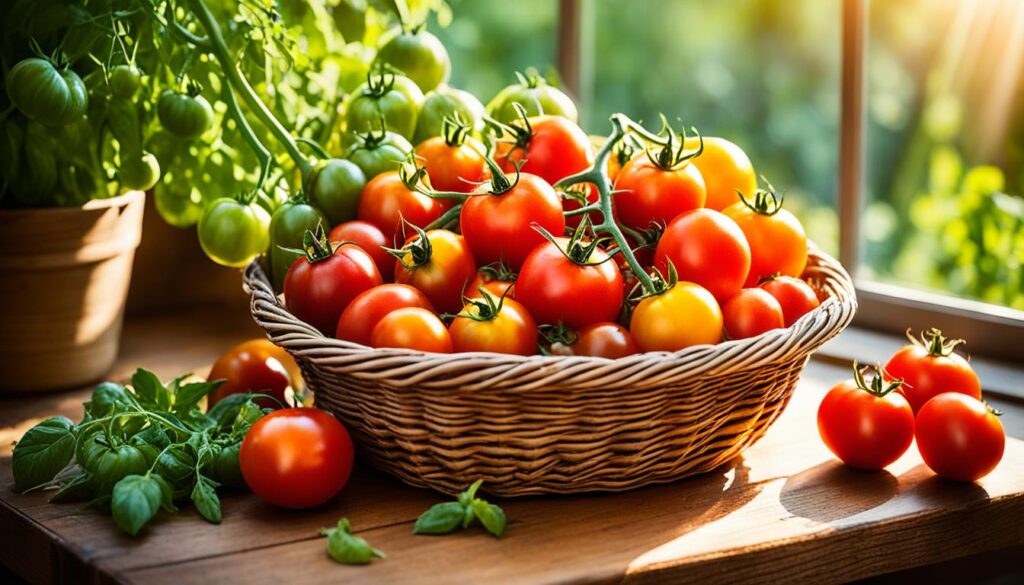
2. “The Basket of Apples” by Paul Cézanne
Post-Impressionist painter Paul Cézanne changed the game with his still life paintings. His masterpiece “The Basket of Apples” shows his genius. Made in 1895, it features a big tomato among other fruits and vegetables. This shows Cézanne’s love for the natural world and his unique geometric style.
Description and Analysis
“The Basket of Apples” is about 65cm x 80cm big. It shows Cézanne’s skill in perspective and form. The objects look like they’re floating, with the tomato and apples seeming to defy gravity. The colors he used, like bright reds, greens, yellows, and browns, make the painting pop.
The shadows suggest a directional light coming from behind the viewer. This adds depth to the scene. Cézanne’s closed composition makes you feel like you’re looking down, creating a personal connection with the still life.
Historical Context
“The Basket of Apples” changed modern art history. It led to the Cubist movement and inspired many artists. Cézanne’s new way of seeing perspective and form broke with tradition. His use of geometric shapes and bold colors hinted at the big changes of the 20th century.
The tomato in the painting shows Cézanne’s deep interest in the natural world. It’s a key part of his art, along with the botanical illustrations. This edible motif has made the painting a favorite in food art and vegetable symbolism.
3. “Tomatoes and a Green Pepper” by Henri Matisse
Henri Matisse’s “Tomatoes and a Green Pepper” is a vibrant still life. It shows the artist’s love for bright colors and lively compositions. Painted in 1905, it features ripe tomatoes and a green pepper against a lively background.
Matisse used vivid colors and light and shadow to add energy. This shows his focus on color and form.
Description and Analysis
In “Tomatoes and a Green Pepper,” Matisse shows his skill in still life paintings. His bold colors and forms make the painting dynamic. It captures the essence of the subject in a unique way.
Matisse’s food art and botanical illustrations are known for their vibrant look. This work is a great example of his creative take on edible motifs and kitchen art.
Historical Context
This painting was made during the Fauvist movement. It shows Henri Matisse‘s focus on color and form. Fauvist artists, like Matisse, wanted to go beyond traditional realism.
They used bold colors and dynamic compositions. This painting is a great example of the Fauvist style. It offers a fresh view of the natural world.
“Color helps me to paint. It is the reason I paint.” – Henri Matisse
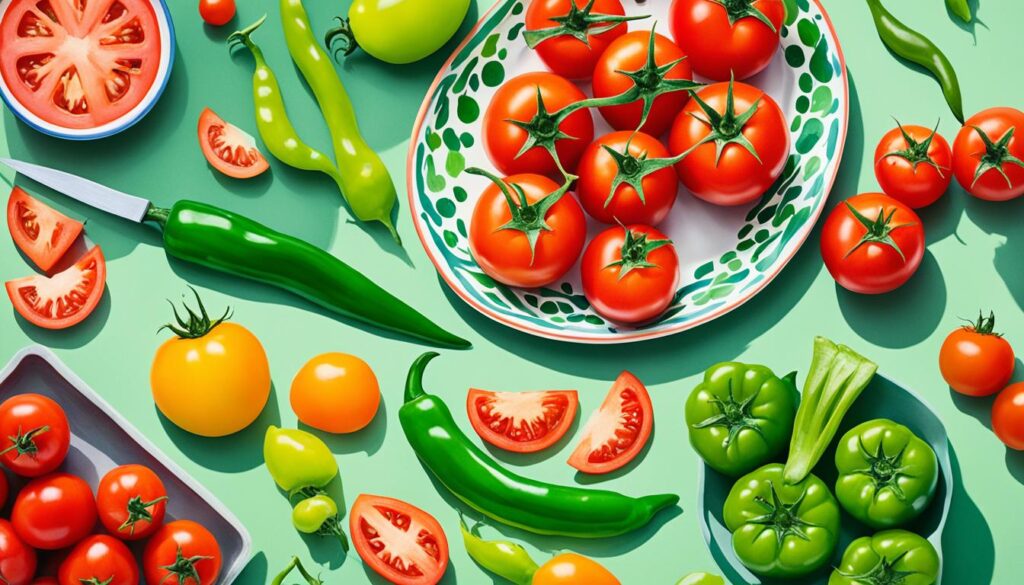
Matisse’s “Tomatoes and a Green Pepper” shows his big impact on art. His unique take on still life painting made his work stand out. It inspires people with its beauty in food art and botanical illustrations.
4. “Still Life with Tomatoes, a Bottle, and a Plate” by Vincent van Gogh
Vincent van Gogh’s painting, “Still Life with Tomatoes, a Bottle, and a Plate,” shows his deep bond with nature. Painted in 1889, it highlights Van Gogh’s unique style. This includes his swirling brushstrokes and bright colors.
Description and Analysis
The painting shows ripe tomatoes, a glass bottle, and a plate. Van Gogh used energy and movement in his art. The tomatoes stand out in red and orange, against the bottle and plate.
Van Gogh’s color choices add depth and texture. This makes the viewer want to look closer at the details. His use of expressive brushstrokes adds life to the painting.
These strokes make the painting feel full of energy. The thick paint makes the work feel real and moving. This style is a key part of Post-Impressionism.
Historical Context
Van Gogh made this painting in 1889, a key time in his career. It came after his famous “Sunflowers” series. This work shows his ongoing interest in still life and nature.
Van Gogh’s bold style has greatly influenced modern art. His work led to the growth of food art and botanical illustrations in the 20th century.
This painting, like Van Gogh’s others, is a favorite. It shows his unique vision and love for nature’s beauty. It continues to inspire art lovers and kitchen artists.
5. “Still Life with Vegetables” by Diego Rivera
Diego Rivera’s “Still Life with Vegetables” is a captivating work. It shows the artist’s talent for capturing nature’s vibrancy. Painted in 1923, it features a vibrant arrangement of produce. This includes a big cluster of tomatoes and other common Mexican ingredients.
Description and Analysis
Rivera paid close attention to every detail in this painting. His vivid depiction of the vegetables shows his love for nature. The way he arranged the produce is both striking and masterful.
The tomatoes are a highlight with their rich colors and textures. They grab the viewer’s eye and show Rivera’s skill in capturing food items.
Historical Context
This painting fits into Rivera’s work on Mexican identity and the value of agriculture. It shows his interest in botanical illustrations and edible motifs in Mexican culture. Rivera celebrates the importance of these elements in his country.
Rivera was a pioneer in still life paintings. His unique take on botanical illustrations and edible motifs showed his skill and made a cultural statement. His work highlighted the significance of his heritage.
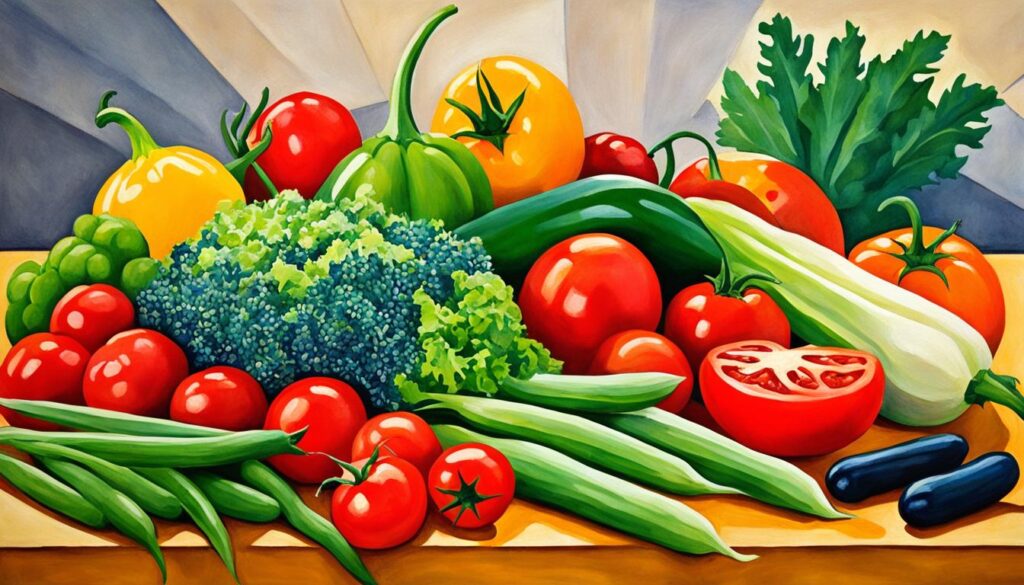
6. “Still Life with Tomatoes” by Samuel Peploe
Samuel Peploe’s “Still Life with Tomatoes” is a captivating work. It shows the artist’s skill in the still life genre. Painted in the early 20th century, it features ripe, juicy tomatoes against a muted background.
Peploe’s bold brushstrokes and focus on light and shadow add depth. They make you want to touch the tomatoes.
Description and Analysis
The vibrant, crimson tomatoes are the main focus of the painting. Peploe uses color and texture to bring them to life. The tomatoes look so real, they seem to reflect the light and cast shadows.
The way Peploe arranged the tomatoes adds to the painting’s appeal. Some are at an angle, others overlap, creating a dynamic look. The background’s earthy tones contrast well, making the tomatoes stand out.
Historical Context
This painting is part of the Scottish Colourist movement. This group of artists used bold colors and light and shadow to capture their subjects. Peploe was one of them, focusing on the essence of his subjects.
The early 20th-century painting shows the tomato’s rise in art. Once seen as just food, tomatoes became a symbol of nature’s beauty. Peploe’s work proves the tomato’s lasting impact in food art and still life paintings.
Samuel Peploe made the tomato a revered subject in art. His work highlights the beauty of botanical illustrations and edible motifs in kitchen art.
7. “The Vegetable Seller” by Bartolomé Esteban Murillo
Bartolomé Esteban Murillo’s “The Vegetable Seller” is a 17th-century masterpiece. It shows the artist’s skill in storytelling. The painting is set in a lively Spanish street. It features a young vendor proudly showing off fresh produce, including juicy tomatoes.
Description and Analysis
Murillo paid close attention to details in this work. He brought warmth and humanity to the scene. His skill is clear as he captures the look and feel of the fruits and vegetables.
The painting grabs your attention with its design and emotion. At the center, a young vendor with a calm look holds up a lot of fresh produce. The colors of the tomatoes and greens make the scene pop, pulling you in.
Historical Context
Murillo made “The Vegetable Seller” during Spain’s Golden Age. This was a time of great art and culture. Murillo, a key Baroque artist, was shaped by the era’s social and economic shifts.
The painting shows a street vendor’s life, showing Murillo’s focus on Spanish society. It highlights the dignity and strength of the working class. Murillo’s use of light, color, and design turns a simple scene into a masterpiece. It invites viewers to see the beauty in everyday life.
“Murillo’s ‘The Vegetable Seller’ is a testament to the artist’s ability to find beauty in the ordinary, elevating the humble into the realm of the sublime.”
8. “Tomatoes in a White Bowl” by Claude Monet
In the world of still life paintings, Claude Monet’s “Tomatoes in a White Bowl” is a standout. Painted in the late 19th century, it shows Monet’s skill in light, color, and texture. This work is a celebration of the simple tomato.
Description and Analysis
The painting shows ripe tomatoes in a white bowl. Monet used vibrant brushstrokes to bring out the light and shadow. This makes the tomatoes look almost real.
Monet’s color choices, from the tomatoes’ deep reds to the bowl’s soft tones, capture the essence of the edible motif. His art invites us to almost touch the tomatoes.
Historical Context
Claude Monet’s “Tomatoes in a White Bowl” shows his impact on the Impressionist movement. This movement focused on light and atmosphere. Monet’s art reflects the beauty of everyday life and how our perception changes.
This painting is a perfect example of Monet’s skill. The tomatoes and light show his unique style. “Tomatoes in a White Bowl” is a beloved piece in kitchen art and botanical illustrations.
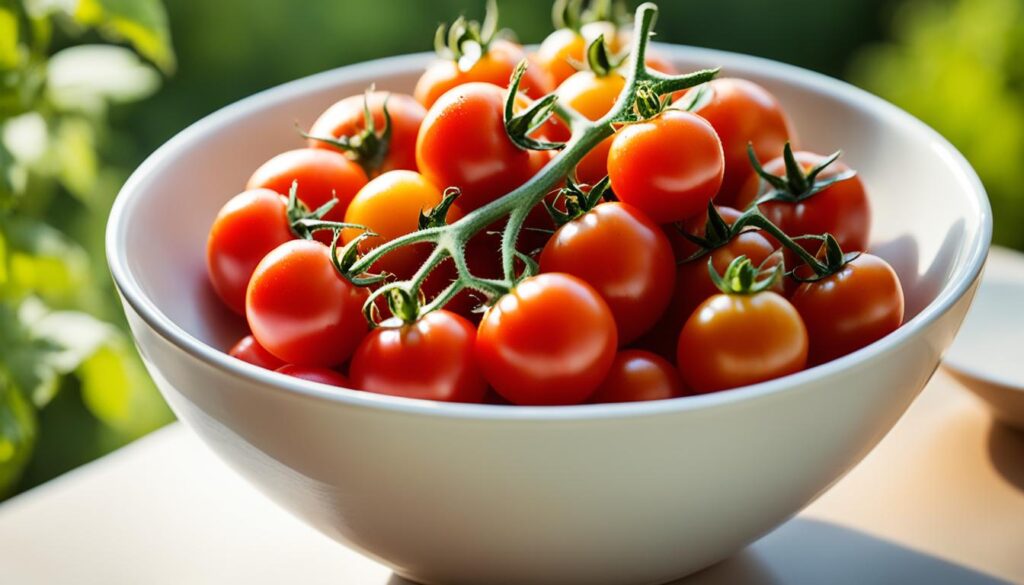
“Monet’s ‘Tomatoes in a White Bowl’ is a stunning example of the artist’s mastery of light and color, inviting the viewer to almost reach out and pluck the tomatoes from the canvas.”
9. “The Tomato Pickers” by Camille Pissarro
Camille Pissarro’s “The Tomato Pickers” shows the hard work of picking tomatoes. It was painted in the late 19th century. This still life painting shows farmworkers picking tomatoes. They are shown in Pissarro’s Impressionist style.
Description and Analysis
Pissarro focused on details and movement in this painting. He showed the beauty of rural life and the value of agricultural work. The colors are earthy, and the light is dappled, making the scene peaceful and hardworking.
The brushstrokes are dynamic, showing the workers’ effort. They are picking ripe tomatoes.
Historical Context
This painting fits into Pissarro’s work on social justice and the working class. As an Impressionist, Pissarro loved showing everyday rural life. “The Tomato Pickers” shows the beauty of rural life and the dignity of labor in the late 19th century.
Pissarro’s style is known for bright colors and loose brushwork. This is seen in this food art piece. The painting shows the beauty of plants and food. It also shows Pissarro’s respect for farming that helped communities back then.
“The Tomato Pickers” by Camille Pissarro is a captivating work that captures the labor and vitality of agricultural life, reflecting the artist’s deep appreciation for the rhythms of rural life and the importance of agricultural work.
10. “Tomato Soup Cans” by Andy Warhol
Andy Warhol’s “Tomato Soup Cans” is a key work in Pop Art. It shows his look at consumer culture. Made in 1962, it has 32 Campbell’s Tomato Soup cans in a grid. Each can is in Warhol’s unique style.
Description and Analysis
The “Tomato Soup Cans” painting is made of 32 canvases. Each is 20 inches tall and 16 inches wide. They all show a Campbell’s Tomato Soup can, just like the real thing.
Warhol picked the Campbell’s can for a reason. It’s a common symbol of American life. He put these cans in a grid to show how art can be different.
Historical Context
Warhol showed “Tomato Soup Cans” in his first solo show on July 9, 1962, at the Ferus Gallery in Los Angeles. It was a big change from traditional still-life art. It showed how everyday items could be art.
This painting helped make Warhol a famous artist. It showed how art could be about everyday things. It also influenced food art, kitchen art, and culinary art.
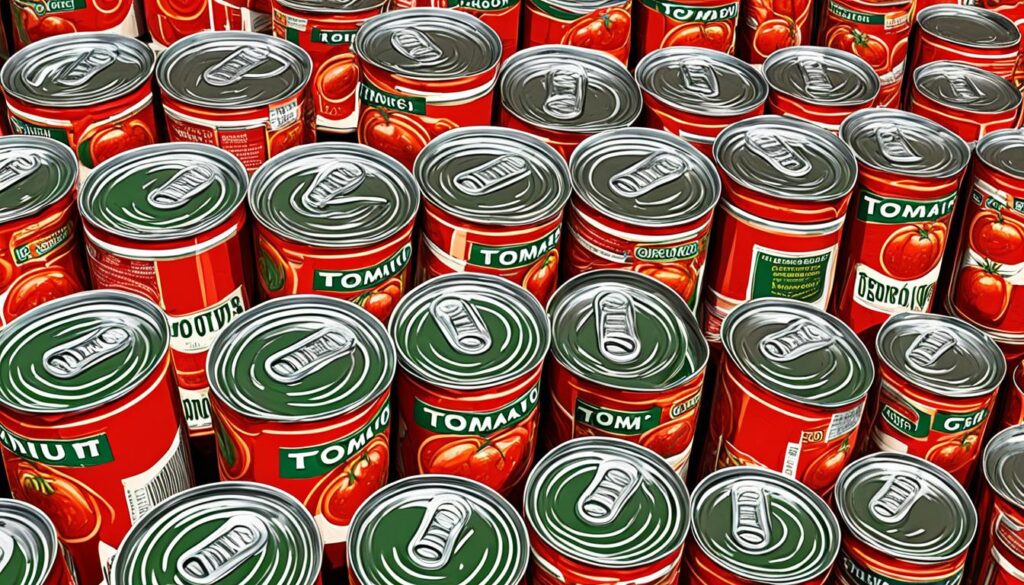
Conclusion
The tomatoes in art show how much we love and value tomatoes in culinary art. Artists have always been drawn to tomatoes. They use them to show off colors, textures, nature, and our feelings.
Artists from the 19th century to today have made tomatoes a key part of their work. They’ve made the tomato a symbol in art, showing its deep connection to food and culture.
The tomato’s story in art is as rich as its history. It has been a favorite subject for many artists. From the bright still lifes of Renoir and Cézanne to Warhol’s bold works, tomatoes have inspired many.
Tomatoes are seen as nature’s gift, a way to play with colors and shapes, and a way to show what it means to be human. They have become a big part of food art, plant drawings, and kitchen decor. As we keep looking at these art pieces, we see how tomatoes can move us and bring us together, crossing time and space.
FAQ
What are some of the most famous paintings featuring tomatoes?
Famous paintings with tomatoes include “Still Life with Tomatoes” by Pierre-Auguste Renoir. Also, “The Basket of Apples” by Paul Cézanne. “Tomatoes and a Green Pepper” by Henri Matisse is another. “Still Life with Tomatoes, a Bottle, and a Plate” by Vincent van Gogh is also well-known. Lastly, “Tomato Soup Cans” by Andy Warhol is a famous piece too.
How have artists used tomatoes to explore different themes and techniques in their work?
Artists have used tomatoes in many ways. They’ve explored still life, Impressionism, Fauvism, Cubism, and Pop Art. Tomatoes show up in vibrant brushstrokes, geometric shapes, and conceptual art. This shows the wide range of artists’ views and styles.
What is the cultural significance of tomatoes in art?
Tomatoes are big in art, showing their cultural value and meaning over time. They started in the Americas and became popular in Europe. Now, they’re a common theme in art, symbolizing nature, farming, and human life.
How have the historical contexts of these paintings influenced the artists’ depictions of tomatoes?
The history of the paintings has shaped how artists show tomatoes. For instance, Renoir’s “Still Life with Tomatoes” reflects France’s love for tomatoes in the late 19th century. Cézanne’s “The Basket of Apples” shows his impact on modern art. These works also mirror big cultural and social changes, like Fauvism and Pop Art.
What are some of the key artistic techniques and styles used by the artists in their depictions of tomatoes?
Artists have used many techniques and styles for tomatoes. They’ve used Impressionist brushwork, Fauvist colors, Cubist shapes, and Pop Art’s look at mass-produced items. These methods show how the artists saw the tomato’s bright colors, textures, and cultural importance.
Source Links
- Everything You Love About Tomatoes, Amplified (Published 2020)
- Art on a plate
- ANITA MAGSAYSAY-HO (PHILIPPINES, 1914-2012), Tomato Pickers
- Yams, Tomatoes, Potatoes, & Plums, & The Trouble of Colonization and Biased Context on Indigenous Australian Art
- Tomatoes as an art form?
- Food origins | Tomatoes · Hünkar Beğendi
- 40 Tomatoes in art Images: PICRYL – Public Domain Media Search Engine Public Domain Search
- Category:Still-life paintings of vegetables
- Category:Tomatoes in art
- Kayla Garrett | Week 2 | Compositional Interpretation of Still Images
- art lesson – Sitka Art Blog
- Foods Art Style Wall Art: Prints, Paintings & Posters | Art.com
- Tomatoes, art and culture | Quantfury Gazette
- Bowl of Tomatoes Original abstract mixed media painting by Sarah Finucane — Sarah Finucane Art
- Tomatoes
- DEMO – Colander and Tomatoes – WetCanvas: Online Living for Artists
- How to Paint Tomatoes (You’ll Be Amazed How Easy This Is!)
- Heirloom Tomatoes & Basil Watercolor Art Print
- List of works by Vincent van Gogh
- Wendingen – Art Blart _ art and cultural memory archive
- Grinnell College Museum of Art
- Still Lives Objects, Fruit, Veg 19th & Later 20th Century Collection
- Still Life with Aubergines 1911 Framed Paintings for Sale
- Wikidata:WikiProject sum of all paintings/Missing depicts/Still life
- Heirloom Tomatoes Print – Acid-free Paper, Archival Inks, Lifelong Col
- 40 Tomatoes in art Images: PICRYL – Public Domain Media Search Engine Public Domain Search
- How to Paint Tomatoes (You’ll Be Amazed How Easy This Is!)
- Campbell’s Soup Cans
- Andy Warhol Accomplishments
- tomato soup – German translation – Linguee
- Sixteenth-century tomatoes in Europe: who saw them, what they looked like, and where they came from
- tomatoes – Deb Anderson, painting
- Three Small Plum Tomatoes
